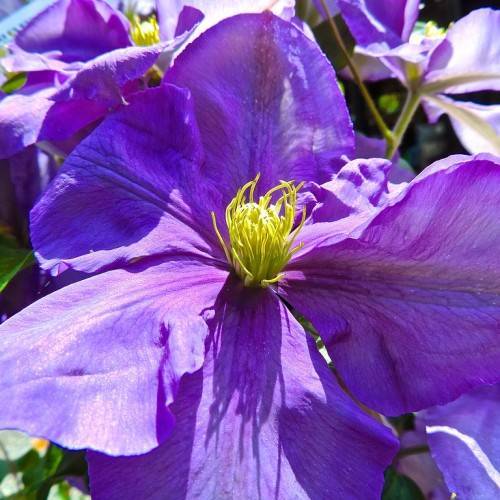
clematis
Clematis 'General Sikorski'
Cycle:
Perennial
Watering:
Average
Hardiness Zone:
4 - 9
Flowers:
Flowers
Sun:
Full sun,part shade
Leaf:
Yes
Growth Rate:
High
Maintenance:
Low
Salt Tolerant:
Yes
Care Level:
Medium
watering
The Clematis 'General Sikorski' is generally considered to be quite drought-tolerant, but it will benefit from regular, deep watering sessions. For best results, try to water this plant at least once a week in the growing season, providing enough moisture to thoroughly soak the soil down to about 6 inches. During periods of heat or drought, the Clematis 'General Sikorski' may need to be watered more frequently, so keep a close watch on the soil and provide enough water for it to remain evenly moist. Over-watering should be avoided, as the roots of the plant should be allowed to dry slightly between waterings.
sunlight
Clematis 'General Sikorski' is a vigorous, climbing, deciduous vine that prefers full sun during the growing season (Spring – Fall). For best flowering, this plant species should receive a minimum of 6 hours of direct sunlight each day. During the hottest times of the day, it is best to provide a little bit of light shade or filtered sunlight to help protect the plant from direct hot sunlight. If the plant is receiving too much shade, however, it may stunt growth and flowering.
pruning
For Clematis 'General Sikorski', the best time for pruning is in late winter or early spring. Because of its vigor, you may need to prune this variety more often, but no more than once a year. It is best to light-prune the plant to preserve the flowers and keep it a reasonable size. Cut out any dead or diseased wood and old growth. Cut around half of the previous season's growth back to a pair of healthy buds near the base of the shoots and thin out any overcrowding in the middle. This will leave plenty of room for the flowers to bloom and grow.
Season
Hardiness Map
FAQ
Can Clematis plants grow in pots?
Yes, Clematis plants can definitely be grown in pots. When planting a Clematis in a pot make sure to use a larger size pot with drainage holes and fill it with a mix of well-draining potting soil and compost. Ensure to keep the root area cool and the pot in a sunny location while providing regular water and fertilization. Check the plant almost daily to make sure it is not becoming too dry. Clematis can do well in a pot and with the right care and conditions, they will thrive.
Are Clematis plants self-pollinating?
No, clematis plants are not self-pollinating. Clematis plants need pollinators such as bees, butterflies, moths and other insects to transfer pollen from the male anthers to the female stigma of the flower in order to produce viable seed. Pollination must also occur within relatively close proximity of the same species in order to create viable hybrid plants.
Can Clematis plants be grown as a houseplant?
Yes, Clematis plants can be grown as a houseplant. It is best to grow them in a pot with full sun and a soil that is rich in organic material and retains moisture. When potting the plant, place a stake or trellis next to the pot so that the vine can climb when it begins to grow. Be sure to water your Clematis plant regularly to keep it healthy and growing. Additionally, keep an eye out for pests and treat with natural insecticides as necessary.
Could Clematis plants survive in a colder climate?
Yes, Clematis plants can survive in colder climates with proper preparation. If planted in the fall, proper mulching should be done to protect the roots from cold temperatures. If planted in the spring, they should be watered frequently to help them adjust to the cooler temperatures more quickly. If temperatures drop below -20°C ( -4°F), additional measures may need to be taken such as the application of protective wraps and thermal insulation. Additionally, plants in exposed areas should be protected from the wind to prevent excessive dehydration. With the right measures in place, Clematis plants can easily survive in colder climates.
Could Clematis plants be grown in a greenhouse?
Yes, clematis plants can be grown in a greenhouse. Due to their vine-like growth habit and tropical native origins, clematis plants thrive in the moist and warm environment of a greenhouse. Clematis are generally grown from cuttings or from dividing existing plants, and benefit from regular pruning and fertilizing. They will also enjoy the indirect light of a greenhouse and the protection from strong winds and temperatures that the humidity and contained environment provides.
